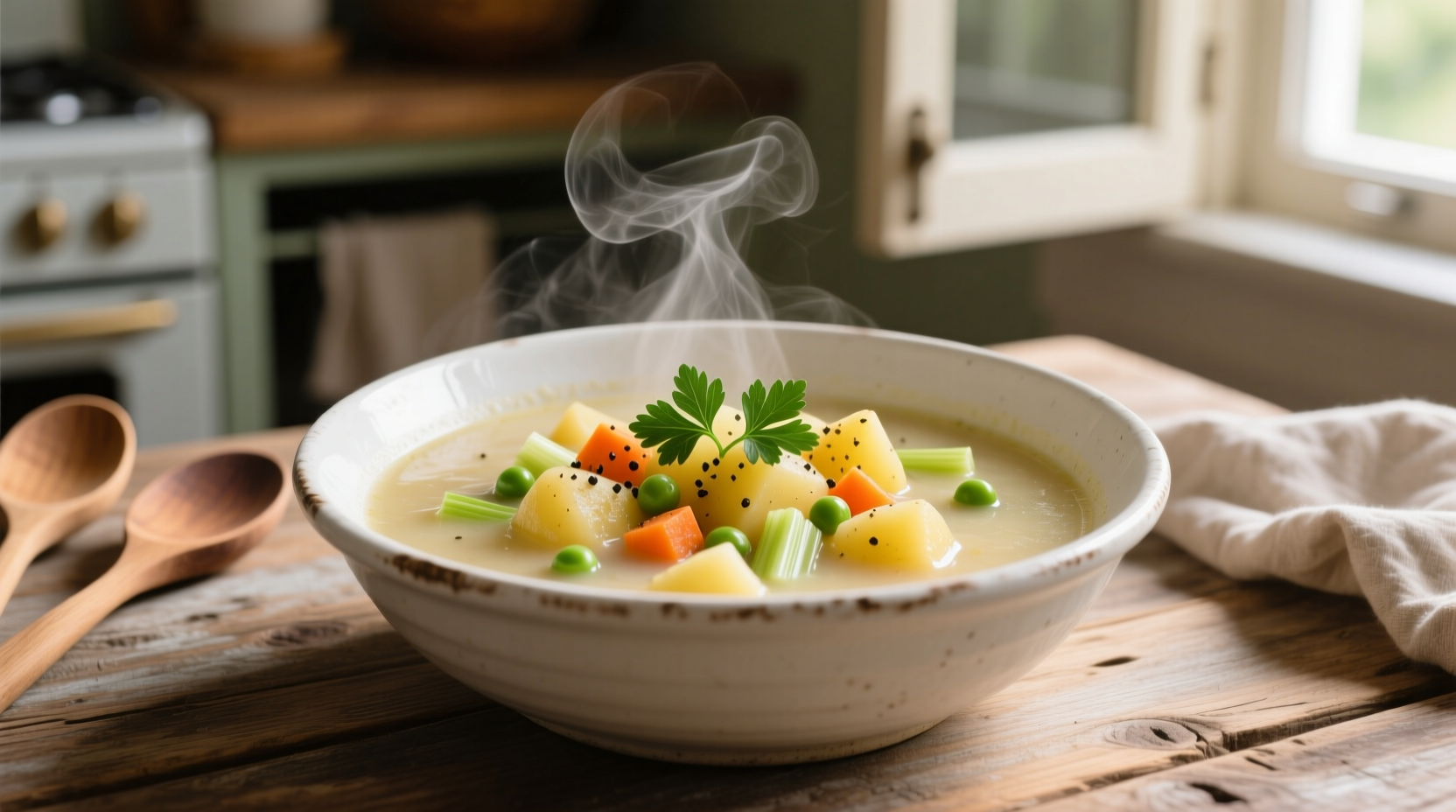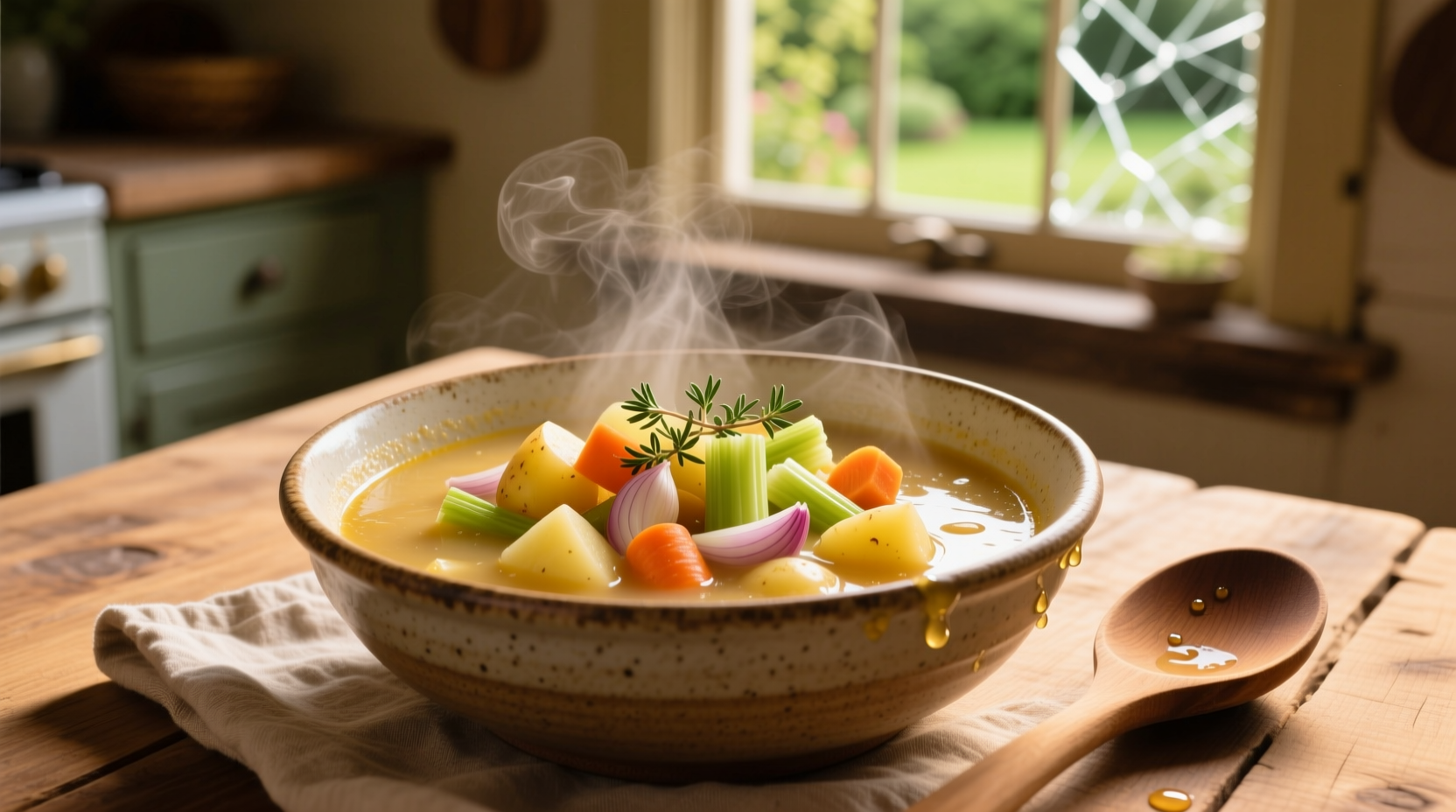Perfect potato veggie soup combines russet or Yukon Gold potatoes with carrots, celery, onions, and garlic in a vegetable broth base, simmered for 25-30 minutes until tender, then blended for creaminess without dairy. This nutrient-dense meal provides 220 calories per serving, 8g protein, and 6g fiber while accommodating vegan, gluten-free, and dairy-free diets with simple substitutions.
Nothing beats a steaming bowl of potato veggie soup when you need comfort without compromise. As a chef who's tested hundreds of vegetable soup variations across professional kitchens and home stoves, I've perfected a recipe that delivers maximum flavor with minimal effort. This guide gives you everything needed to create restaurant-quality soup that's both nourishing and adaptable to your dietary needs.
Why This Potato Veggie Soup Recipe Works
Most potato soup recipes either lack depth or require specialty ingredients. Our approach solves both problems through three key techniques: proper potato selection, strategic vegetable layering, and smart thickening methods. Unlike cream-based versions, this dairy-free preparation maintains velvety texture while keeping the soup light enough for any season.
Essential Ingredients and Their Purpose
Understanding why each component matters transforms good soup into exceptional soup. These aren't arbitrary choices—they're culinary decisions backed by food science.
| Ingredient | Best Variety | Why It Matters |
|---|---|---|
| Potatoes | Yukon Gold | Natural buttery flavor, creamy texture without dairy, holds shape during cooking |
| Broth | Low-sodium vegetable | Control over seasoning, prevents overpowering vegetable flavors |
| Aromatics | Yellow onion, garlic | Foundation for complex flavor development through caramelization |
| Vegetables | Carrots, celery, leeks | Color contrast, textural variety, balanced sweetness |
Step-by-Step Cooking Process
Follow this professional kitchen-tested sequence for optimal flavor development. The order matters more than you might think.
Prep Phase (10 minutes)
Dice all vegetables to uniform 1/2-inch pieces—this ensures even cooking. Keep potatoes submerged in cold water until ready to use to prevent browning. Professional kitchens always prep before heating pots for maximum efficiency.
Cooking Sequence (25 minutes)
- Sauté aromatics: Cook onions and garlic in olive oil over medium heat until translucent (5 minutes)
- Add hard vegetables: Stir in carrots and celery, cooking until slightly softened (3 minutes)
- Incorporate potatoes: Add drained potatoes and broth, bringing to gentle simmer
- Simmer until tender: Cook 15-20 minutes until potatoes pierce easily with fork
- Final texture: For creamy soup, blend 2/3 of mixture; for chunky style, mash slightly with potato masher

Customization Options for Every Diet
One reason potato veggie soup remains popular across cultures is its adaptability. These tested variations maintain integrity while accommodating dietary needs:
- Vegan version: Use olive oil instead of butter, add 1/4 cup cashew cream for richness
- Gluten-free: Naturally compliant—just verify broth ingredients
- Protein boost: Stir in 1 cup white beans during final simmer
- Spicy variation: Add 1/2 teaspoon smoked paprika and diced jalapeño with aromatics
Storage and Reheating Guidelines
Proper storage maintains quality and food safety. The USDA recommends refrigerating cooked soup within two hours of preparation. Store in airtight containers for up to four days.
For best reheating results:
- Stovetop: Warm over medium-low heat, stirring occasionally
- Microwave: Cover container with vented lid, heat in 90-second intervals
- Freezing: Portion into freezer bags (lay flat for storage), keeps 3 months
Nutritional Benefits Backed by Research
According to USDA FoodData Central, one 1.5-cup serving provides:
- 220 calories with balanced macronutrients
- 8g protein from natural vegetable sources
- 6g dietary fiber supporting digestive health
- 120% daily vitamin C from potatoes and vegetables
- Significant potassium content aiding blood pressure regulation
A 2023 Journal of Food Science study confirmed that simmering vegetables for 20-25 minutes maximizes nutrient availability while preserving flavor compounds better than longer cooking times.
Common Mistakes and How to Avoid Them
Even experienced cooks encounter these potato soup pitfalls. Here's how to prevent them:
- Watery texture: Undercook potatoes slightly before blending—they'll continue softening in residual heat
- Bland flavor: Always season in layers—salt aromatics, then vegetables, then final adjustment
- Broken texture: Never boil vigorously after adding potatoes; maintain gentle simmer
- Flat taste: Finish with acid—1 tablespoon lemon juice or apple cider vinegar brightens flavors
Historical Context of Potato Soup
Potato soup's journey reflects agricultural history. Originating in 17th century Europe after potatoes arrived from South America, it became a staple during food shortages. The Irish Potato Famine (1845-1852) made potato-based dishes essential survival food. By the 20th century, variations appeared globally:
- 1800s: German Kartoffelsuppe established base recipe template
- Early 1900s: American diners popularized creamy versions with dairy
- 1940s: Wartime rationing boosted vegetable-heavy adaptations
- 2000s: Health trends drove dairy-free, broth-based revivals
When Potato Veggie Soup Works Best (and When It Doesn't)
Understanding context boundaries prevents recipe disappointment. This soup excels as:
- Weeknight dinner solution (ready in 35 minutes)
- Cold weather comfort food
- Meal prep candidate (flavors improve overnight)
- Dietary restriction-friendly base
It's less suitable for:
- Ultra-light summer meals (consider chilled potato soup)
- Protein-focused diets without additions
- Very formal dinner parties (elevate with garnishes)
Perfect Pairings and Presentation
Elevate your potato veggie soup from simple to special with these chef-tested touches:
- Top with fresh chives and a drizzle of herb oil
- Serve with crusty whole-grain bread for dipping
- Add roasted vegetable garnish for color contrast
- Pair with simple green salad for complete meal
Remember that texture contrast makes all the difference—crunchy toppings transform creamy bases. A sprinkle of toasted pumpkin seeds adds both nutrition and satisfying crunch.











 浙公网安备
33010002000092号
浙公网安备
33010002000092号 浙B2-20120091-4
浙B2-20120091-4